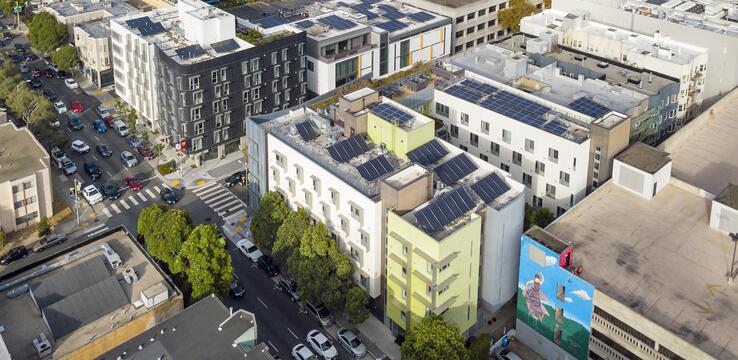
Update: Since this article appeared in our print magazine, this legislation has passed into law and is now in effect.
In June 2023, San Francisco Mayor London Breed introduced legislation designed to meet the state-mandated goal of building 82,000 homes in San Francisco within eight years. Although it operationalizes a policy that was already approved by the Board of Supervisors earlier this year, this legislation may prove to be one of the most significant housing reforms of Breed’s administration. SPUR, along with many other pro-housing organizations in the city, has long advocated for streamlining the approvals process to make housing easier, faster, and cheaper to build. SPUR Director of Special Projects Annie Fryman took to social media to explain why everyone should care about this complicated, dry- as-toast piece of city policy. Below is a condensed (and safe-for-work) version of Annie’s primer to what she dubbed “Mayor Breed’s Big Boring Housing Legislation.”
SF’s Mayor London Breed just introduced what could be the most impactful and wide-spanning housing reforms of her 5 years in office to date. If you get under the hood, these reforms are a very big deal.
The package of 13 loosely related code changes sounds like a kitchen sink — and it is, because what makes housing hard to build in SF is all the layers of small requirements. Untangling this mess requires peeling it all off with a scalpel, layer by layer.
To boil it down, the legislation makes three big moves:
First, it removes most requirements for conditional use permits and mandatory public hearings.
You might be wondering: what is a conditional use permit? SF has long had a *legal requirement* that many types of housing are exceptions to the norm and require special permission to be built. To get the go-ahead, they must go through dramatic, drawn-out, public hearings. In the past, city codes basically said “we kiiiinda want these types of housing, but we’re not sure, and the only way to be sure is to require someone to come to City Hall and beg at a public hearing.”
Conditional use adds cost and slows things down. It is a disservice to SF residents (current AND future!) because it says an unelected body must give you permission to live here. On a case-by-case basis. The decision is usually based on vibes, not rules.
It’s worth mentioning that conditional use requirements almost exclusively harm renters because they mostly apply to multifamily housing. If you can afford a single-family home, the city doesn’t give you much grief. But apartment buildings? They must beg for special permission.
Mayor Breed’s legislation abolishes conditional use and mandatory public hearings for most types of housing and new construction. (!!!!!!)
So, NO MORE HEARINGS REQUIRED for apartments proposed on large lots, tall buildings, disability accommodations, many demolitions on the West Side and other wealthy neighborhoods, density bonus projects, senior housing, homeless shelters, group housing, and home-based businesses.
Finally, city planners will be allowed to do their ACTUAL job: planning for housing. And architects can do theirs: designing housing. Developers can turn money into housing. Construction workers can build housing that’s been approved by the city. And so on.
Second, it cuts as much as $100,000–$150,000 in fees that San Francisco has historically charged to each new unit of affordable housing. (You read that right.) (Yep.)
Some background: SF funds much of city government through fees put on every new housing unit (a regressive practice that actually makes projects less competitive for state funding sources). Mayor Breed’s legislation changes will align city policy with the reality that we need housing for low- and middle-income people *more* than we need the fee revenue that comes from building housing for them.
This legislation waives many low/middle-income affordable housing units from paying fees. Because it costs the city budget — and the community — a whole lot more to not have plentiful affordable housing. Secure housing is the backbone for families’ well-being, cultural memory, and economic health.
Third, it does away with restrictions in the SF Planning Code that don’t make sense for a fair, dense, multiuse, and vibrant city.
For one, the legislation erases geographic requirements that say you can’t have new senior housing, homeless shelters, group housing, or home-based businesses in all San Francisco neighborhoods.
It also does away with an SF law (one that has been in place for the entirety of the city’s housing shortage) that says that, to get a permit to build or renovate, you have to send a letter asking for permission to all neighbors who live within 150 feet.
Once they get the letter, neighbors can say “no actually, I don’t like it” and stop the project. After all, you had to ask for permission! Mayor Breed is getting rid of this requirement.
The legislation also eases rigid, inflexible requirements for balconies, inner courtyards, and ground-floor apartment uses like shared laundry, mail rooms, bike storage, and lobbies. Why does this change matter? Much of city planning and architecture is actually about navigating a maze of strict, confusing, and often conflicting rules.
The design you get at the end represents the delicate (and strange) path that complied with all the rules. Making the Planning Code more flexible on the “where” and “what” means the projects SF allows are the projects San Fran- ciscans want. And the sum of all the projects SF gets makes up the city San Franciscans get. Let’s make it a good one.
